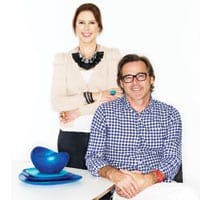This week, your Friday Entrepreneur Fix features the founders of Dinosaur Designs, design-duo Louise Olsen and Stephen Ormandy.
Louise Olsen and Stephen Ormandy are the picture of a highly-functioning husband and wife business partnership.
The pair established Dinosaur Designs in 1987 after meeting at the Sydney City Art Institute (now CoFA), and have grown their small homewares and jewellery business into an international exporter with 70 employees and a store in New York.
Olsen and Ormandy’s business has seen much change over the past three decades, but one thing has remained constant – their wares are still designed and manufactured in Australia, something they’re very proud of, and rightfully so.
How has this creative pair managed to build their small business into an iconic Australian brand? They share their biggest challenges and the secrets to living and working together harmoniously with Dynamic Business.
Q. Do you think it’s important for entrepreneurs to be able to make mistakes?
Olsen: We started as a very small business and we were lucky that we learned a lot, and made a lot of mistakes, while we were still small enough to be able to do that.
We really grew into this company. We now have a really good idea of how it operates and how it works best for us.
Q. You hired a business coach three years ago, how has that worked out for you?
Ormandy: Until that point the business had grown very organically; we’d done some things intuitively but didn’t realise that others were causing us problems just because of the way things were structured.
What our coach did was give us a basic corporate structure which you could use to run anything from a corner shop to Telstra. We divided the business into four [sales, production, creative and business] with a head of each. It was a fundamental shift but so simple.
It took all the complexity out of it and gave everyone a sense of purpose. Our staff all need to have an investment in us outside of just getting a pay cheque. Nearly everyone here is very creative.
Q. It’s a tough time to be in retail, how are you managing this?
Ormandy: People are time poor and they have to make the effort to come back into your store. You have to give them a reason to do that and it’s a challenge.
It’s even tougher with online. You’ve got to make going into a store a wonderful experience.
Q. You now export products to 20 countries internationally, so do you have any advice for dealing with Intellectual Property (IP) issues?
Ormandy: With IP, you have to have a Doberman ready to go and there’s no point in taking someone on unless you’re prepared to go all the way. It doesn’t matter if it’s a multinational or a corner store. We usually win because they copy us directly and, because we hand mould everything, it’s easy to prove.
Olsen: All of a sudden you open up the floodgates to the rest of the world and you’ve got to be prepared for that. [But] as a designer, you have to keep moving on and keep one step ahead.
Q. Ever get tired of living and working together?
Olsen: Both my parents were artists who worked from home and it was always very harmonious. We’ve created that here as well. We have a certain style we’ve created together; we have a basic philosophy. But we can be critical of each other’s work and not take it personally.
It’s really healthy to have buoyant discussions and it’s important that we have those. It’s not a power struggle.
Q. What’s the most challenging thing about running a business?
Olsen: Our employees. I feel very responsible for these 70 people who give us their time to help create what we love. A lot of them really give us their all and we want to make sure they get looked after.

